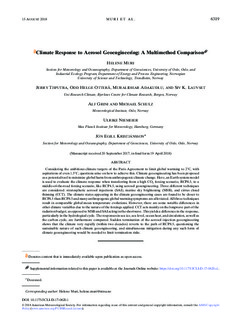Climate response to aerosol geoengineering: a multi-method comparison
| dc.contributor.author | Muri, Helene | |
| dc.contributor.author | Tjiputra, Jerry | |
| dc.contributor.author | Otterå, Odd Helge | |
| dc.contributor.author | Adakudlu, Muralidhar | |
| dc.contributor.author | Lauvset, Siv Kari | |
| dc.contributor.author | Grini, Alf | |
| dc.contributor.author | Schulz, Michael | |
| dc.contributor.author | Niemeier, Ulrike | |
| dc.contributor.author | Kristjansson, Jon Egill | |
| dc.date.accessioned | 2019-03-28T09:24:23Z | |
| dc.date.available | 2019-03-28T09:24:23Z | |
| dc.date.created | 2018-04-30T11:29:12Z | |
| dc.date.issued | 2018 | |
| dc.identifier.citation | Journal of Climate. 2018, 31 (16), 6319-6340. | nb_NO |
| dc.identifier.issn | 0894-8755 | |
| dc.identifier.uri | http://hdl.handle.net/11250/2592111 | |
| dc.description.abstract | Considering the ambitious climate targets of the Paris Agreement to limit global warming to 2°C, with aspirations of even 1.5°C, questions arise on how to achieve this. Climate geoengineering has been proposed as a potential tool to minimize global harm from anthropogenic climate change. Here, an Earth system model is used to evaluate the climate response when transferring from a high CO2 forcing scenario, RCP8.5, to a middle-of-the-road forcing scenario, like RCP4.5, using aerosol geoengineering. Three different techniques are considered: stratospheric aerosol injections (SAI), marine sky brightening (MSB), and cirrus cloud thinning (CCT). The climate states appearing in the climate geoengineering cases are found to be closer to RCP4.5 than RCP8.5 and many anthropogenic global warming symptoms are alleviated. All three techniques result in comparable global mean temperature evolutions. However, there are some notable differences in other climate variables due to the nature of the forcings applied. CCT acts mainly on the longwave part of the radiation budget, as opposed to MSB and SAI acting in the shortwave. This yields a difference in the response, particularly in the hydrological cycle. The responses in sea ice, sea level, ocean heat, and circulation, as well as the carbon cycle, are furthermore compared. Sudden termination of the aerosol injection geoengineering shows that the climate very rapidly (within two decades) reverts to the path of RCP8.5, questioning the sustainable nature of such climate geoengineering, and simultaneous mitigation during any such form of climate geoengineering would be needed to limit termination risks. | nb_NO |
| dc.language.iso | eng | nb_NO |
| dc.publisher | American Meteorological Society | nb_NO |
| dc.subject | Climate change | nb_NO |
| dc.subject | Klimaendringer | nb_NO |
| dc.subject | Oseanografi | nb_NO |
| dc.subject | Oceanography | nb_NO |
| dc.subject | Geoengineering | nb_NO |
| dc.subject | Jordsystem modell | nb_NO |
| dc.subject | Earth system model | nb_NO |
| dc.title | Climate response to aerosol geoengineering: a multi-method comparison | nb_NO |
| dc.type | Journal article | nb_NO |
| dc.type | Peer reviewed | nb_NO |
| dc.description.version | publishedVersion | nb_NO |
| dc.subject.nsi | VDP::Meteorologi: 453 | nb_NO |
| dc.subject.nsi | VDP::Meteorology: 453 | nb_NO |
| dc.source.pagenumber | 6319-6340 | nb_NO |
| dc.source.volume | 31 | nb_NO |
| dc.source.journal | Journal of Climate | nb_NO |
| dc.source.issue | 16 | nb_NO |
| dc.identifier.doi | 10.1175/JCLI-D-17-0620.1 | |
| dc.identifier.cristin | 1582476 | |
| dc.relation.project | Notur/NorStore: NS9033K | nb_NO |
| dc.relation.project | Notur/NorStore: nn9448k | nb_NO |
| dc.relation.project | Norges forskningsråd: 229760 | nb_NO |
| dc.relation.project | Notur/NorStore: nn9182k | nb_NO |
| dc.description.localcode | © 2018 American Meteorological Society. Locked until 11.1.2019 due to copyright restrictions. | nb_NO |
| cristin.unitcode | 194,64,25,0 | |
| cristin.unitname | Institutt for energi- og prosessteknikk | |
| cristin.ispublished | true | |
| cristin.fulltext | postprint | |
| cristin.qualitycode | 2 |
